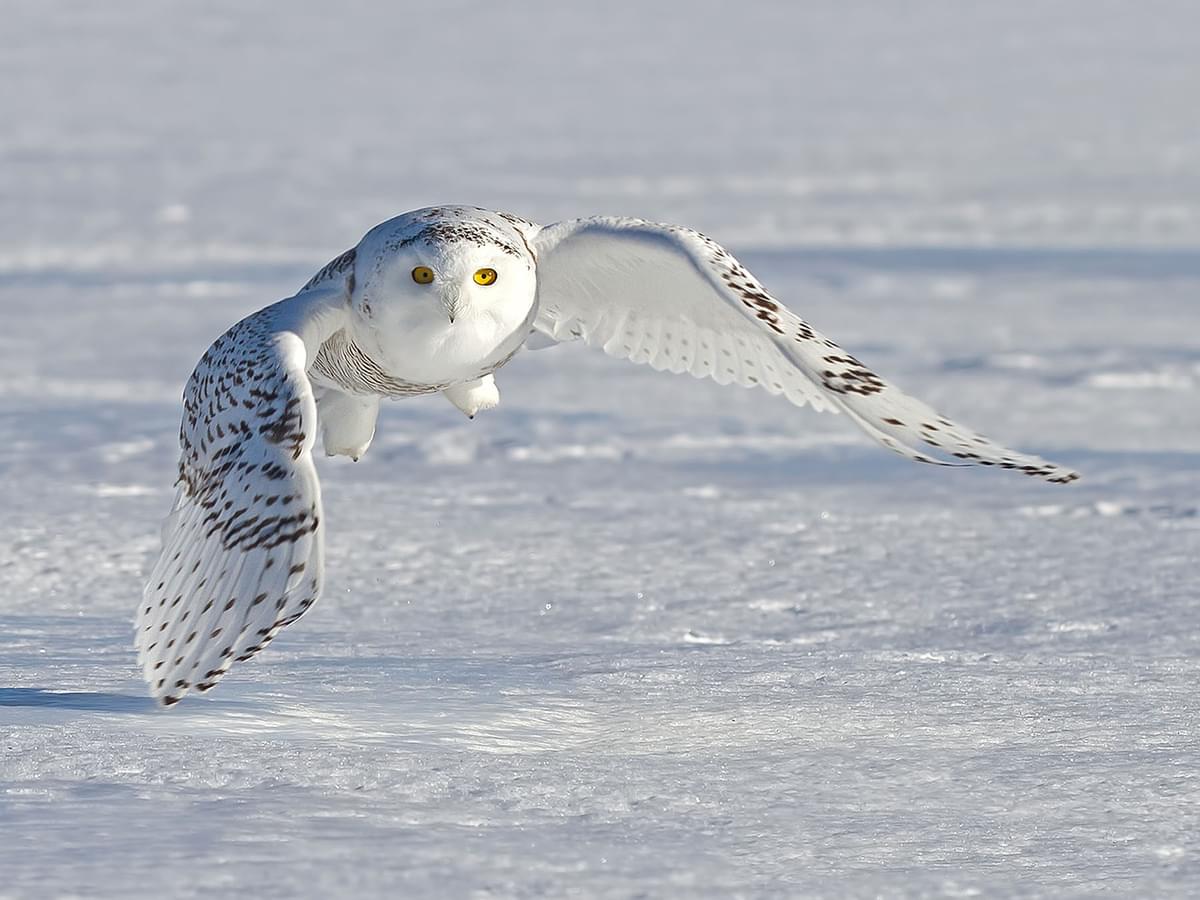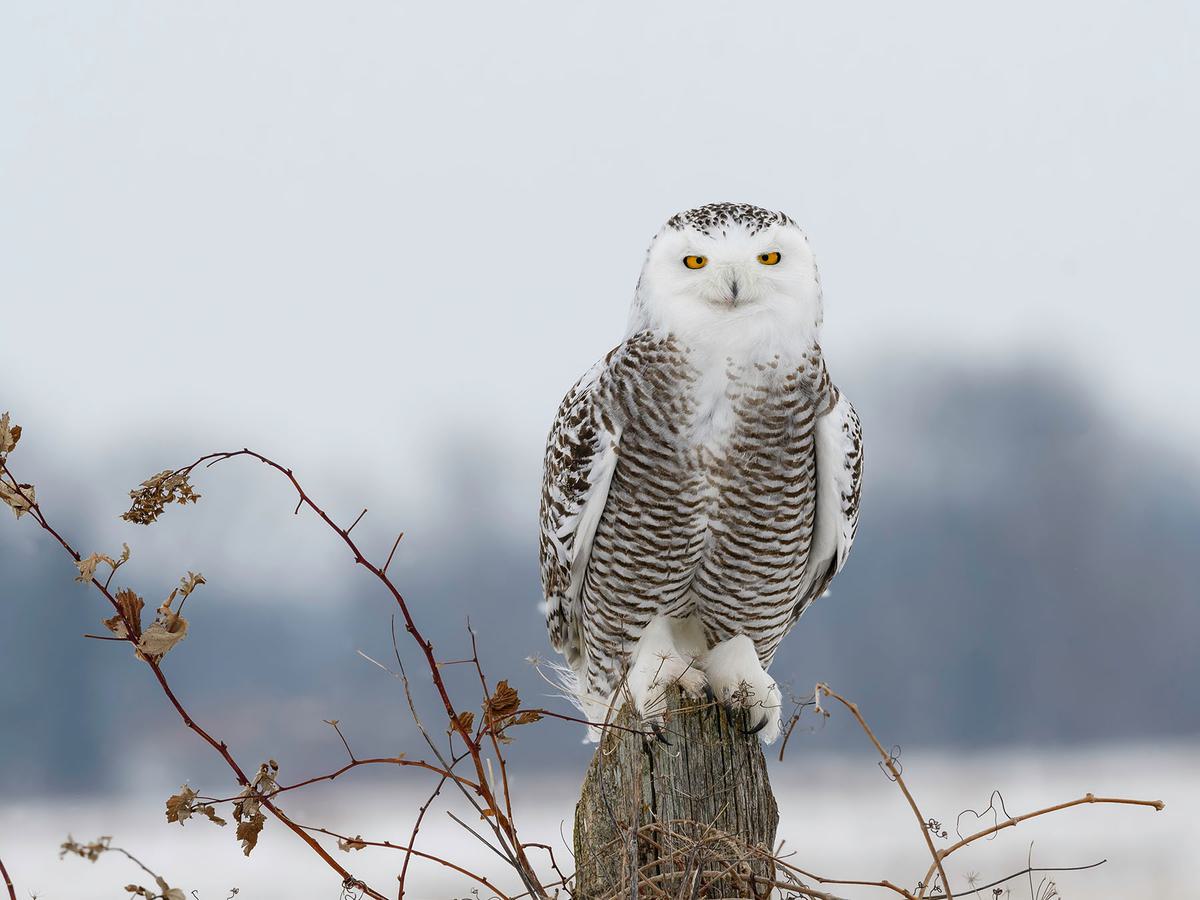Jump to Section
Are Snowy Owls Endangered? (Threats, Numbers + FAQs)
Last updated: 14 November 2022

Snowy owls are among the most widely recognized, despite being one of the rarest. These north-dwelling owls make their home across much of the Arctic, ranging from the furthest reaches of northern Canada and Russia to as far south as the Great Lakes, isolated parts of the USA, northern Europe, and the UK.
This emblematic species inhabits some of the most inhospitable environments on the planet and relies on a fragile balance of food sources, nesting sites, and favorable weather conditions to survive. Here, we’ll answer the question: are Snowy owls endangered?
In 2018, Snowy owls were listed as Vulnerable on the International Union for Conservation of Nature (IUCN) Red List. The Red List is the IUCN’s inventory of threatened, vulnerable, and endangered animals. Studies show that Snowy owl populations have plummeted to around 28,000 from 200,000 in 2013.
The IUCN quote that if the decline in Snowy owls “proves to be even higher, the species may be eligible for further uplisting to ‘endangered.”
Estimating Snowy owl populations has always been tricky as they seem to follow a “boom and bust” pattern that fluctuates with prey availability. It’s possible that recent numbers reflect a “bust” in the Snowy owl population, but climate modeling suggests that global warming is greatly affecting numbers.
Read on to learn more about how and why the glorious Snowy owl is endangered.

Snowy Owls are listed as a vulnerable species
Why did Snowy Owls go endangered?
Snowy owl populations are exceedingly hard to estimate, partly because they live in largely unpopulated and isolated parts of the world and partly because their populations fluctuate naturally.
Further, Snowy owls have a massive range covering an incredible 12,000,000 km2 (4,600,000 sq mi), and some migrate back and forth between continents. For example, one female Snowy owl tracked in 2012 traveled approximately 7,000 miles back and forth from Boston, Massachusetts, to Nunavut, Canada.
Despite how tricky it is to quantify Snowy owl populations, current data suggests that the population has declined from over 200,000 birds to around 28,000 in 2018. The North American population has declined by around 52% to 64% since the 1960s. This placed the species on the IUCN’s Red List in 2018, where they’re listed as Vulnerable.

Snowy Owl landing in a snow covered field, Ottawa, Canada
Snowy owls rely on lemmings
Snowy owls rely primarily on lemmings as a food source. Evidence suggests that lemming populations are moving northward closer to the Arctic as temperatures warm up.
Data shows northward lemming movements are impacting many predators that rely on them for food, such as stoats, Snowy owls, Arctic foxes, and Long-tailed skuas.
The fragmented northward movements of lemmings are a significant factor in why Snowy owls are becoming endangered. This has caused the ‘lemming cycle’ to collapse, which has a knock-on effect on animals that rely on lemmings as a food base. When lemmings vanish from the owls’ feeding grounds, they inevitably starve.
On years when lemming populations become hard to predict, or simply when lemmings fail to breed, or when they die too early in winter, Snowy owl populations fall to dangerously low levels. This is confirmed by studies in Greenland that link collapses in lemming populations with a massive decline in owl, stoat, and Arctic fox productivity.

Lemmings are the primary source of a Snowy Owls diet
Snowy owls and climate change
Changes to lemming populations accompany numerous other climate-related factors, such as altered migratory behavior, changes to vegetation composition, increased disease and parasite risk, risk of hyperthermia, rapid changes to weather conditions, etc.
While Snowy owl populations are known to fluctuate naturally, climate models and numerous data suggest that declines are no longer part of a natural cycle.
It’s near-unequivocal that human-driven climate change is impacting Snowy Owl populations, making their lives tougher across the already-inhospitable fringes of the Arctic.

Close up of a Snowy owl flying low
What threats do Snowy Owls have?
Snowy owls are apex predators that have no natural predators as adults. Instead, their main threats come from their environment, climate change, illegal hunting, and collisions with vehicles and power lines.
Recent studies show that climate change is instrumental in the rapid population decline of this elegant and emblematic bird.
These snow and ice-dwelling birds evolved to thrive in habitats in which few other large animals can survive. While the Arctic environment is dynamic and never remains constant, Snowy owls formerly adapted to seasonal and year-on-year changes by migrating further south or north.
Today, accelerating changes to the Arctic is altering the landscape at an unprecedented rate. Snowy owls are one of many species suffering from changes to their habitat - their role in the ecosystem depends on a fragile balance that has been impaired by climate change.

Climate change is one of the biggest threat to Snowy Owls
What is the biggest threat to Snowy Owls?
Recent declines in Snowy owl populations are largely attributed to changes in their primary food source: lemmings.
Lemmings are common across the Arctic and tundra regions and are the staple food of many Arctic predators.
Changes to Arctic environments resulting from global warming and climate change are causing lemming populations to fluctuate and collapse. This has a knock-on effect which is proving to be Snowy owls’ most significant threat. Studies in Greenland confirm that Snowy owls depend on lemming populations, which all but collapsed in some parts of the world.
How do humans affect Snowy Owls?
Humans have directly hunted and trapped Snowy owls for decades. Human settlements are displacing owls from regions across their range and disrupting their food supplies.
However, the biggest impact humans have on Snowy owls is largely indirect. Human-caused climate change and global warming are melting the ice caps and causing dramatic changes to the fragile ecosystems that Snowy owls and other species depend on.
Like Polar bears, penguins, seals, and numerous other much-loved cold-dwelling animals, Snowy owls are dying out because of global warming.

Close up of a Snowy Owl calling whilst perched on the ground
How can we help Snowy Owls?
Snowy owl populations are declining due to global warming and climate change. To save them, we must take the same steps required to save many other thousands of vulnerable and endangered species.
Human activity’s long-established role in global warming must change. Slowing and reversing global warming will take an immense effort, but if each person contributes, this seemingly impossible task becomes possible.
Saving energy, changing dietary habits, using less plastic, recycling, and engaging in green and sustainable movements and behaviors will help Snowy owls and thousands of other vulnerable species.
Meanwhile, conservation efforts are instrumental in stabilizing Snowy owl populations and protecting breeding females and young chicks.

Close up portrait of a Snowy Owl perched on a post
How many Snowy Owls are in the wild?
Current data suggests there are around 28,000 Snowy owls in the world today (14,000 breeding pairs), but this could be as low as 14,000 individuals.
This has dropped since pre-2018, when an estimated 200,000 to 257,000 Snowy owls were in the wild. However, it’s challenging to estimate populations due to natural year-on-year fluctuations, but the data is nevertheless indicative of rapid population decline.
Snowy owls are listed as Vulnerable on the IUCN Red List.
How rare is it to see a Snowy Owl?
Spotting a Snowy owl in the wild is extremely rare. While there are some sightings as far south as the US cities of Washington and Boston, the north of the UK, and central Europe, Snowy owls are mostly confined to the cold tundra and Arctic.
Very rarely, vagrants are found even further south across central and southern Europe and the southern states.

Snowy Owl hunting for prey in a field
What state has the most Snowy Owls?
Snowy owls are found in most Canadian states at some point in the year. They breed further north, in Nunavut, Yukon, Northwest Territories, Newfoundland, and northern Quebec.
In the US, they’re most common in the northeastern states but are found in the Pacific Northwest and Midwest during winter too. They also breed in Alaska.
What country has the most Snowy Owls?
Canada, Russia, and Scandinavia are home to the majority of the world’s Snowy owl population.
The Arctic and Arctic tundra covers a vast area towards the North Pole, which is where most Snowy owls live. However, their wintering range extends southwards to southern Canada, the north USA, and parts of northern and central Europe.

Snowy Owl perched in the snow, Manitoba, Canada
Is it illegal to kill a Snowy Owl?
In the USA, under federal and state law, it is illegal to injure, harass, kill, or possess a bird of prey, including Snowy owls. However, some authorities are exempt, like airports.
However, Alaskan hunting regulations allow the residents of some states to harvest Snowy Owls in certain areas, so long as the birds are used for food or clothing.
The killing of Snowy owls is also illegal across Canada and much of Europe.
Are Snowy Owls endangered in Canada?
Snowy owls are considered vulnerable in every part of the world, according to the IUCN. Canada’s on the Status of Endangered Wildlife in Canada (COSEWIC) doesn’t consider the bird endangered, but it hasn’t been reassessed since 1995.
On this page
- Why did Snowy Owls go endangered?
- What threats do Snowy Owls have?
- How can we help Snowy Owls?
- How many Snowy Owls are in the wild?
- How rare is it to see a Snowy Owl?
- What state has the most Snowy Owls?
- What country has the most Snowy Owls?
- Is it illegal to kill a Snowy Owl?
- Are Snowy Owls endangered in Canada?



